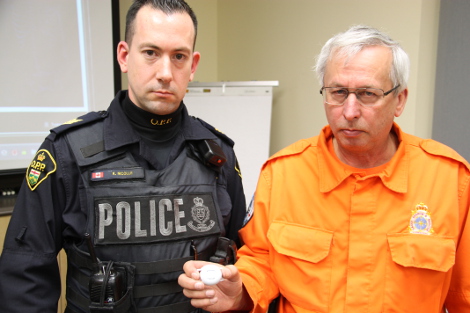The Sault Ste. Marie OPP detachment is partnering with Sault Search and Rescue in expanding the reach of Project Lifesaver.
The Sault Ste. Marie Police Service has been working as a partner in Project Lifesaver with Sault Search and Rescue since 2012 within city limits.
At a media conference held at Sault OPP headquarters Thursday, it was announced Project Lifesaver will be expanded to include the Sault OPP's area of jurisdiction.
The Sault OPP detachment is the first in Northeastern Ontario to take part in Project Lifesaver.
With the new partnership, the Sault Search and Rescue operational area will range from Montreal River to St. Joseph Island.
Project Lifesaver uses radio transmitting bracelets to locate people who are prone to wander due to disorders such as Alzheimer's disease, autism or Down Syndrome.
With Project Lifesaver, caregivers may contact Sault Search and Rescue at 705 759 5878, fill out the necessary paperwork and purchase a radio transmitting bracelet for a loved one to wear, making it easier to locate them if they should wander off and go missing.
If such an individual wanders off, it is critical 9-1-1 be called immediately.
9-1-1 operators then contact Sault Search and Rescue, who will then work with Sault Police or OPP to locate that person using a Project Lifesaver receiver.
The bracelet gives off a signal which is picked up by the Sault Search and Rescue receiver, and the missing individual is found.
When needed, Sault Search and Rescue workers (all volunteers, on call 24 hours a day) have always been successful in locating people who have wandered off, said Randy Roy, Sault Search and Rescue president.
Sault Search and Rescue currently has 24 active clients, with another eight in nursing homes.
The bracelets, purchased from Sault Search and Rescue, cost $400 each.
Sault Search and Rescue workers visit clients' homes every two months and change the batteries in the bracelets for $20.
The bracelets and search equipment were originally purchased by Sault Search and Rescue from Project Lifesaver in the U.S. with the help of Ontario Trillium Fund money.
Corporate donations from local law firm Feifel, Broadbent and Gualazzi, Soo Mill and OLG, along with money raised in fundraisers, have also helped Sault Search and Rescue run Project Lifesaver.
"It's a project that hits home with lots of people, a lot of people know somebody with Alzheimer's disease or autism, so the funding was good to get," Roy said.
"This is a great opportunity for our teams to work together, to make life a little safer for those people who are suffering from dementia, Down syndrome or autism and also gives caregivers another tool in their toolbox…with this tool at least they have a little comfort knowing we're going to be out there looking for them."
The average search time with Project Lifesaver, within Sault Ste. Marie city limits, is 30 minutes, Roy said.
Both Roy and Sgt. Keith Nicolle, the Sault OPP officer in charge of Project Lifesaver in the Sault OPP area, said search times within the outlying OPP area, with its wide expanse of bush, will take longer.
Searches could take a couple of hours but Sault Search and Rescue workers will be constantly training in simulated situations to get that time down, Roy said.
"We're hoping to expand it (Project Lifesaver) in the Northeast region, Alzheimer's is an illness that's expanding quite rapidly, the number of people with Alzheimer's is only going to increase over time and it's important programs like this are in place to save lives," Nicolle said.
"From a Search and Rescue perspective we were getting a lot of calls from people in the outlying areas and referring them to the OPP, so those calls helped prompt us to encourage everybody to get on board," Roy said.
"We also have people in Sault Ste. Marie who have camps out in the outlying areas so it's important for that area to be covered as well, if you have a bracelet on and go to camp, we'll still be looking for you and we have lots of trained personnel to get out there and get that job done," Roy said.
Some clients have shown some reluctance to wear the bracelets, but the bracelets can be made to look like wrist watches if necessary.
Project Lifesaver began in Chesapeake, Virginia in 1998 and is now used by by law enforcement agencies and organizations throughout the U.S., Canada and Australia, and is expanding rapidly due to the increase in cases of disorders such as Alzheimer's disease.
(PHOTO: Sault OPP Sgt. Keith Nicolle and Randy Roy, Sault Search and Rescue president, with a Project Lifesaver transmitter, December 10, 2015. Darren Taylor/SooToday)

